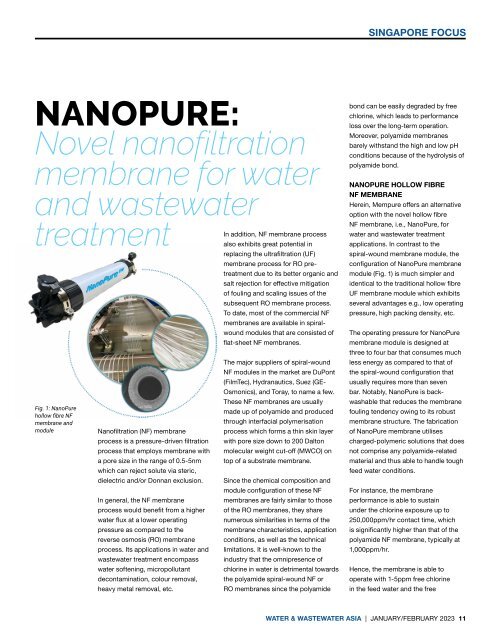Water & Wastewater Asia January/February 2023
Water & Wastewater Asia is an expert source of industry information, cementing its position as an indispensable tool for trade professionals in the water and wastewater industry. As the most reliable publication in the region, industry experts turn this premium journal for credible journalism and exclusive insight provided by fellow industry professionals. Water & Wastewater Asia incorporates the official newsletter of the Singapore Water Association (SWA).
Water & Wastewater Asia is an expert source of industry information, cementing its position as an indispensable tool for trade professionals in the water and wastewater industry. As the most reliable publication in the region, industry experts turn this premium journal for credible journalism and exclusive insight provided by fellow industry professionals. Water & Wastewater Asia incorporates the official newsletter of the Singapore Water Association (SWA).
You also want an ePaper? Increase the reach of your titles
YUMPU automatically turns print PDFs into web optimized ePapers that Google loves.
SINGAPORE FOCUS<br />
NANOPURE:<br />
Novel nanofiltration<br />
membrane for water<br />
and wastewater<br />
treatment<br />
Fig. 1: NanoPure<br />
hollow fibre NF<br />
membrane and<br />
module<br />
Nanofiltration (NF) membrane<br />
process is a pressure-driven filtration<br />
process that employs membrane with<br />
a pore size in the range of 0.5-5nm<br />
which can reject solute via steric,<br />
dielectric and/or Donnan exclusion.<br />
In general, the NF membrane<br />
process would benefit from a higher<br />
water flux at a lower operating<br />
pressure as compared to the<br />
reverse osmosis (RO) membrane<br />
process. Its applications in water and<br />
wastewater treatment encompass<br />
water softening, micropollutant<br />
decontamination, colour removal,<br />
heavy metal removal, etc.<br />
In addition, NF membrane process<br />
also exhibits great potential in<br />
replacing the ultrafiltration (UF)<br />
membrane process for RO pretreatment<br />
due to its better organic and<br />
salt rejection for effective mitigation<br />
of fouling and scaling issues of the<br />
subsequent RO membrane process.<br />
To date, most of the commercial NF<br />
membranes are available in spiralwound<br />
modules that are consisted of<br />
flat-sheet NF membranes.<br />
The major suppliers of spiral-wound<br />
NF modules in the market are DuPont<br />
(FilmTec), Hydranautics, Suez (GE-<br />
Osmonics), and Toray, to name a few.<br />
These NF membranes are usually<br />
made up of polyamide and produced<br />
through interfacial polymerisation<br />
process which forms a thin skin layer<br />
with pore size down to 200 Dalton<br />
molecular weight cut-off (MWCO) on<br />
top of a substrate membrane.<br />
Since the chemical composition and<br />
module configuration of these NF<br />
membranes are fairly similar to those<br />
of the RO membranes, they share<br />
numerous similarities in terms of the<br />
membrane characteristics, application<br />
conditions, as well as the technical<br />
limitations. It is well-known to the<br />
industry that the omnipresence of<br />
chlorine in water is detrimental towards<br />
the polyamide spiral-wound NF or<br />
RO membranes since the polyamide<br />
bond can be easily degraded by free<br />
chlorine, which leads to performance<br />
loss over the long-term operation.<br />
Moreover, polyamide membranes<br />
barely withstand the high and low pH<br />
conditions because of the hydrolysis of<br />
polyamide bond.<br />
NANOPURE HOLLOW FIBRE<br />
NF MEMBRANE<br />
Herein, Mempure offers an alternative<br />
option with the novel hollow fibre<br />
NF membrane, i.e., NanoPure, for<br />
water and wastewater treatment<br />
applications. In contrast to the<br />
spiral-wound membrane module, the<br />
configuration of NanoPure membrane<br />
module (Fig. 1) is much simpler and<br />
identical to the traditional hollow fibre<br />
UF membrane module which exhibits<br />
several advantages e.g., low operating<br />
pressure, high packing density, etc.<br />
The operating pressure for NanoPure<br />
membrane module is designed at<br />
three to four bar that consumes much<br />
less energy as compared to that of<br />
the spiral-wound configuration that<br />
usually requires more than seven<br />
bar. Notably, NanoPure is backwashable<br />
that reduces the membrane<br />
fouling tendency owing to its robust<br />
membrane structure. The fabrication<br />
of NanoPure membrane utilises<br />
charged-polymeric solutions that does<br />
not comprise any polyamide-related<br />
material and thus able to handle tough<br />
feed water conditions.<br />
For instance, the membrane<br />
performance is able to sustain<br />
under the chlorine exposure up to<br />
250,000ppm/hr contact time, which<br />
is significantly higher than that of the<br />
polyamide NF membrane, typically at<br />
1,000ppm/hr.<br />
Hence, the membrane is able to<br />
operate with 1-5ppm free chlorine<br />
in the feed water and the free<br />
WATER & WASTEWATER ASIA | JANUARY/FEBRUARY <strong>2023</strong> 11


















